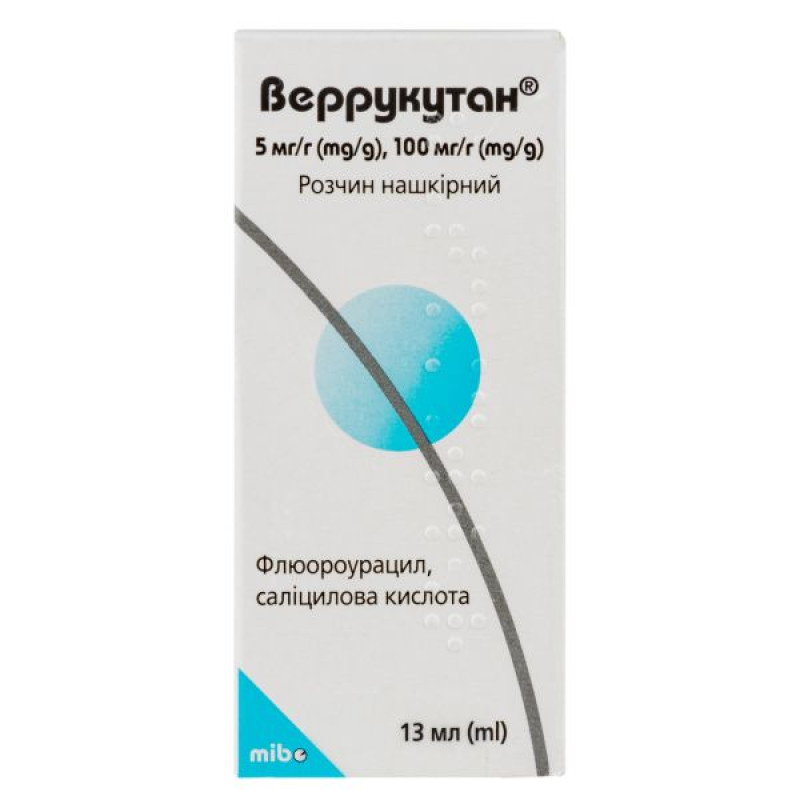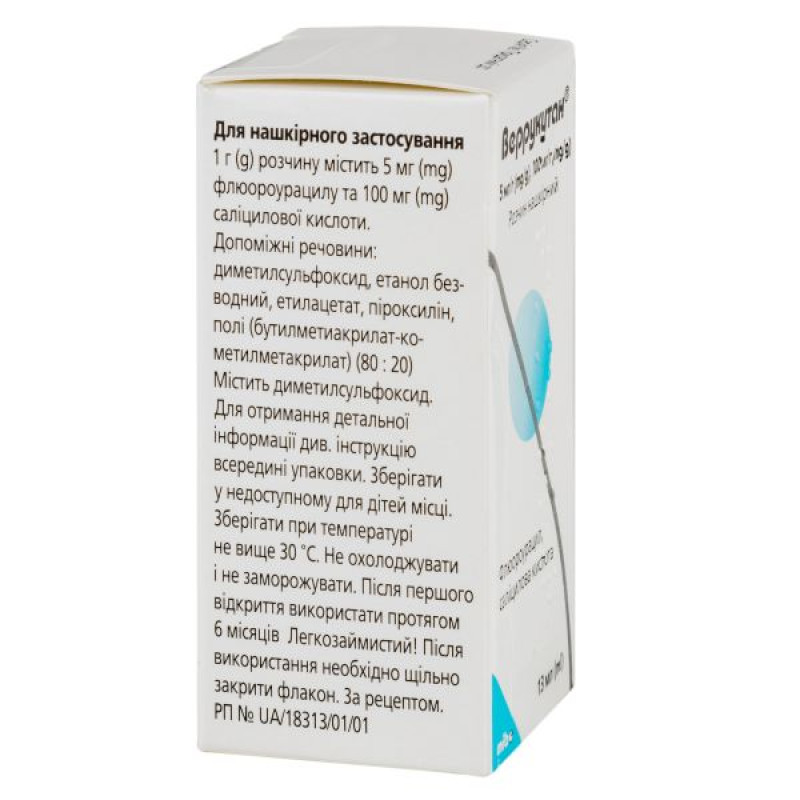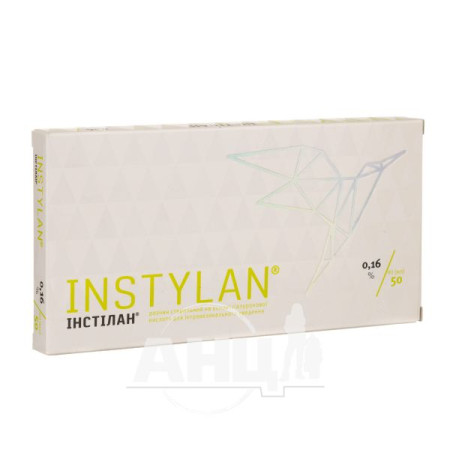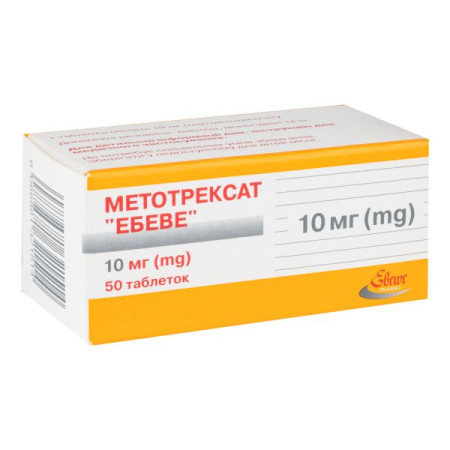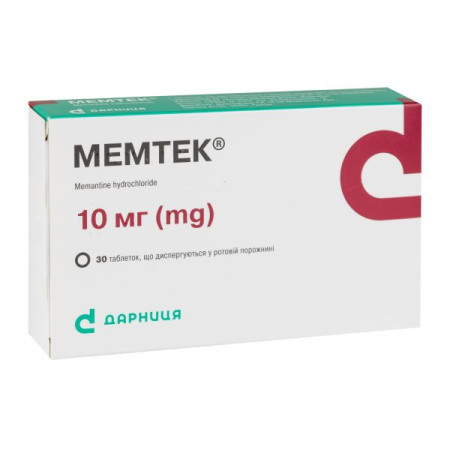Verrucutan cutaneous solution 100+5mg/ml 13 ml
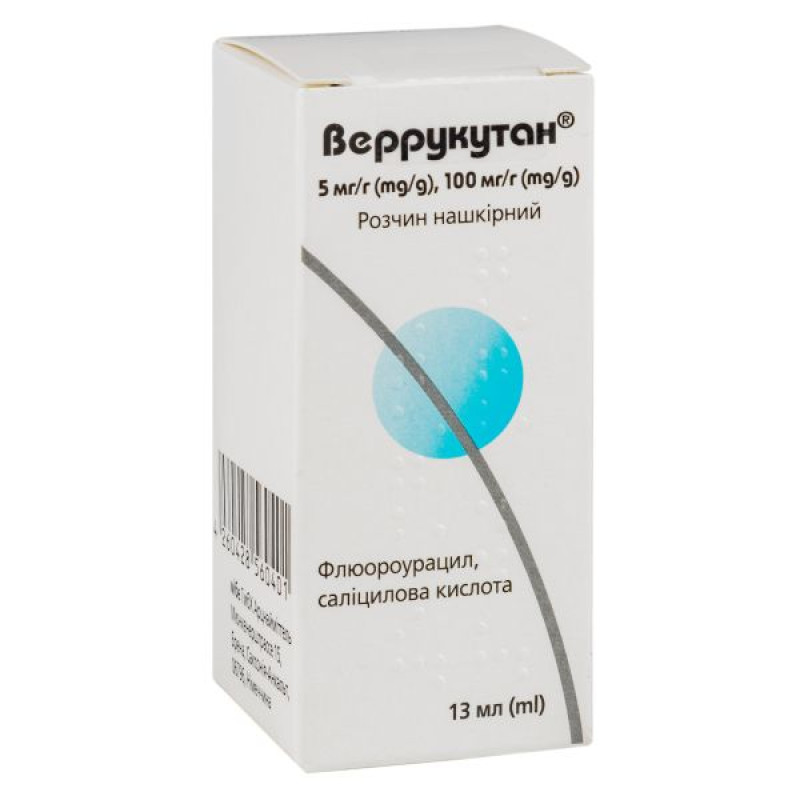
Instructions Verrucutan cutaneous solution 100+5mg/ml 13 ml
Composition
active ingredients: fluorouracil, salicylic acid;
1 g of solution contains 5 mg of fluorouracil and 100 mg of salicylic acid;
excipients: dimethyl sulfoxide, anhydrous ethanol, ethyl acetate, pyroxylin, poly (butyl methacrylate-co-methyl methacrylate) (80:20).
Dosage form
The solution is topical.
Main physicochemical properties: clear solution from colorless to slightly orange.
Pharmacotherapeutic group
Other dermatological preparations. Wart and callus preparations. ATX code D11AF.
Pharmacological properties
Pharmacodynamics
The active substance fluorouracil (FU) is a cytostatic agent with antimetabolic effects.
Due to its structural similarity to thymine, which is found in nucleic acids (5-methyluracil), FU prevents its formation and metabolism, and therefore inhibits the synthesis of both DNA and RNA. As a result, the growth of the wart virus is inhibited and its suppression occurs, especially those wart cells that are in the stage of accelerated growth and therefore absorb FU in an increased volume.
Salicylic acid has a keratolytic effect when applied topically. Salicylic acid is an aromatic acid and a lipid-soluble phenol. By mechanism of action, it is a keratolytic and corneolytic agent, which probably acts according to the mechanism of adhesion to corneocytes, the effect of dissolving the intercellular cement, releasing and separating corneocytes. Due to its mechanism of action as an organic solvent, salicylic acid can remove intercellular lipids that are covalently bound to the horny layer of cells, known as the "corneal envelope".
Pharmacokinetics
In an absorption study in pigs, fluorouracil was not detected in the blood plasma after dermal application of even large amounts of Verrucutan®, i.e. the active substance is not absorbed in quantities that can be determined by standard analytical methods (HPLC).
According to recent studies, the degree of absorption of fluorouracil in humans after the use of Verrucutan® is significantly lower than 0.1%.
After application to the skin, Verrucutan® forms a hard film that turns white after the solvent evaporates. The result is an occlusive effect that promotes the penetration of the active substance into the deeper layers of the wart.
Salicylic acid is added to the composition due to its keratolytic properties, thereby facilitating the penetration of the active ingredient, which is particularly difficult in the case of warts. The same is achieved by dimethyl sulfoxide, a solubilizing agent for the active ingredient FU.
The keratolytic effect of salicylic acid is due to its direct effect on intercellular cement substances known as desmosomes, which promotes the keratinization process.
Based on pharmacokinetic studies in animals and humans, it has been found that the penetration of salicylic acid is rapid, depending on the formulation base and factors affecting penetration, such as skin condition.
Salicylic acid is metabolized by conjugation with glycine to salicylic acid, with glucuronic acid at the phenolic OH group to a glucuronide ester, and with the COOH group to a glucuronide ester, or by hydroxylation to gentisic acid or dihydroxybenzoic acid. The elimination half-life of salicylic acid is 2–3 hours in the normal dose range and may increase to 15–30 hours at high doses due to the limited ability of the liver to conjugate salicylic acid.
With topical application of salicylic acid (taking into account contraindications), no toxic side effects are generally expected, since serum levels above 5 mg/dl are almost never reached. Early symptoms of salicylate intoxication may only occur at serum levels above 30 mg/dl.
Indication
Common warts (especially warts on the areas of the foot that bear the greatest load), flat juvenile warts of the extremities.
Contraindication
Hypersensitivity to the active substances or to any of the excipients listed in the "Composition" section.
Verrucutan® should not be used in women who are breastfeeding, pregnant, or in women whose pregnancy cannot be ruled out with certainty.
Verrucutan® should not be used in infants and patients with renal insufficiency.
Verrucutan® should not be used concomitantly with brivudine, sorivudine and analogues. Brivudine, sorivudine and their analogues are potent inhibitors of dihydropyrimidine dehydrogenase (DPD), the enzyme that breaks down fluorouracil (see also sections “Special warnings and precautions for use” and “Interaction with other medicinal products and other types of interactions”).
Verrucutan® is not intended for use on large skin surfaces (the skin surface should not exceed 25 cm2).
Avoid contact of Verrucutan® with eyes and mucous membranes.
Interaction with other medicinal products and other types of interactions
The enzyme dihydropyrimidine dehydrogenase (DPD) plays an important role in the breakdown of fluorouracil. Nucleoside analogues, such as brivudine and sorivudine, can cause a significant increase in plasma concentrations of fluorouracil and other fluoropyrimidines, and therefore cause a corresponding increase in their toxicity. For this reason, a break of at least 4 weeks should be allowed between the use of fluorouracil and the use of brivudine, sorivudine and analogues.
In the event of accidental ingestion of nucleoside analogues such as brivudine and sorivudine by patients treated with fluorouracil, effective measures should be taken to reduce fluorouracil toxicity. Hospitalization is indicated if necessary. All measures to prevent systemic infections and dehydration should be initiated.
Increased plasma levels of phenytoin have been reported with concomitant administration of phenytoin and fluorouracil, leading to symptoms of phenytoin intoxication (see section 4.4).
There is no evidence of any significant systemic absorption of salicylic acid. However, absorbed salicylic acid may interact with methotrexate and sulfonylureas.
Application features
The enzyme dihydropyrimidine dehydrogenase (DPD) plays an important role in the breakdown of fluorouracil. Inhibition, deficiency, or reduced activity of this enzyme can lead to accumulation of fluorouracil.
If necessary, determination of DPD enzyme activity is indicated before starting treatment with fluorouracil or other fluoropyrimidines. Patients taking phenytoin concomitantly with fluorouracil should be regularly monitored for increased phenytoin plasma levels.
On areas of skin with warts that have a thin epidermis, the product should be applied less frequently and the course of treatment should be monitored more frequently, since the salicylic acid in Verrucutan® has a powerful effect of softening the stratum corneum of the epidermis, which can cause scarring.
On warts that are prone to keratinization, it is sometimes advisable to first apply a patch with salicylic acid.
Patients with somatosensory disorders (e.g., diabetes mellitus) require close medical monitoring of the treated area.
After each use, the bottle should be tightly closed, as the product can dry out quickly and become unusable.
It should be ensured that during application Verrucutan® does not come into contact with fabrics or acrylic coatings (e.g. acrylic bathtubs), as the solution may cause non-removable stains and the formation of a varnish film.
Warning: Fire hazard: keep away from open flames.
This medicine contains dimethyl sulfoxide (80 mg/g), which may cause skin irritation.
Use during pregnancy or breastfeeding
Pregnancy
There are currently no data available on the topical use of fluorouracil in pregnant women. Teratogenic effects have been observed in animals following systemic absorption of fluorouracil.
Salicylic acid may adversely affect the outcome of pregnancy in rodents.
Verrucutan® should not be used in women whose pregnancy cannot be ruled out with certainty (see section "Contraindications").
Breast-feeding
It is not known whether fluorouracil or its metabolites are excreted in human milk after topical administration. A risk to the newborn cannot be excluded.
Verrucutan® should not be used by women during pregnancy or breastfeeding (see section “Contraindications”).
Fertility
Fertility studies with systemic administration of fluorouracil have shown transient infertility in males and a reduced pregnancy rate in female rodents. However, similar effects in humans are unlikely due to the very low absorption of the active substances after dermal application of Verrucutan®.
Ability to influence reaction speed when driving vehicles or other mechanisms
Verrucutan® has no or negligible influence on the ability to drive or use machines.
Method of administration and doses
Doses
Verrucutan® should usually be applied two to three times a day to each wart. The usual duration of use is 6 weeks. The product should be applied regularly every day. After successful therapy, treatment should be continued for approximately 1 more week.
Application method
For cutaneous use.
Verrucutan® should only come into contact with the wart and not with the healthy skin around the wart; if possible, the surrounding skin should be protected with a plaster or ointment. It is recommended to wipe the spatula on the neck of the bottle before application. For very small warts, it is recommended to use a toothpick or similar instead of a spatula for precise application.
Before each new application of Verrucutan®, the existing film on the skin should be removed by simply pulling it.
In the case of periungual and especially subungual warts, it is necessary to ensure that the nail matrix is not damaged and that Verrucutan® does not get on the nail bed.
The application area should not exceed 25 cm2.
Experience shows that in many cases, such as large common warts and plantar warts, it is beneficial for the doctor to remove dead tissue during treatment with Verrucutan®.
Verrucutan® should not be used in infants.
Overdose
When Verrucutan® is applied to a skin area of 25 cm2, 0.2 g of Verrucutan® is applied, and therefore 1 mg of fluorouracil (FU). For a person weighing 60 kg, 1 mg of FU is equivalent to a dose of 0.017 mg/kg body weight. Systemic intoxication occurs at intravenous doses of 15 mg/kg body weight and can therefore be excluded, given the thousand-fold safety margin.
Moreover, this safety margin is significantly increased because the absorption of FU from Verrucutan® through the skin is negligible (see also the Pharmacokinetics section).
Since serum levels above 5 mg/dl are rarely reached after salicylic acid is absorbed through the skin (see also section "Pharmacokinetics"), salicylate intoxication can be virtually ruled out when Verrucutan® is used according to the instructions.
Early symptoms of salicylate intoxication may occur at serum levels above 30 mg/dL.
They manifest as ringing in the ears, tinnitus with hearing loss, nosebleeds, nausea, vomiting, irritation and dryness of the mucous membranes.
Therefore, when applied to the skin according to the instructions for both active ingredients, systemic intoxication is unlikely (see above). However, if the recommended frequency of application is significantly exceeded, the frequency and severity of local reactions in the area of application increase.
Young children have a different ratio of body surface area to body weight than adults. Therefore, significantly exceeding the maximum recommended treatment area or frequency of application increases the risk of salicylic acid toxicity, especially in young children.
Side effects
The following categories are used to display the frequency of adverse reactions:
Very common (>1/10)
Common (≥1/100 to <1/10)
Uncommon (≥1/1000 to <1/100)
Uncommon (≥1/10,000 to <1/1,000)
Rare (<1/10,000)
Unknown frequency (cannot be estimated from the available data)
| Organ system class | Very common | Frequent | Infrequent | Single-noki | Rare | Unknown frequency |
| From the nervous system | Headache | |||||
| From the organs of vision | Dry eyes, itchy eyes, increased tearing | |||||
| From the skin side | Shelling | |||||
| General disorders and administration site conditions | At the site of application: erythema, inflammation, irritation (including burning sensation), pain, itching | At the site of application: bleeding, skin erosions, crusting | At the site of application: dermatitis, edema, ulcers |
Rarely, a severe burning sensation may lead to discontinuation of treatment.
As a result of the powerful effect of softening the stratum corneum, discoloration and peeling of the skin may occur, especially around the wart.
Due to the salicylic acid content, sensitive patients may experience mild irritation symptoms such as dermatitis and contact allergy reactions, which can manifest as itching, redness and blisters, even outside the contact area (so-called disseminated reactions).
Reporting of suspected adverse reactions
Reporting suspected adverse reactions is very important. Healthcare professionals and patients should report any suspected adverse reactions via the national reporting system.
Expiration date
2 years.
After first opening – 6 months.
Storage conditions
Store at a temperature not exceeding 30. Do not refrigerate or freeze. Keep out of the reach of children.
Packaging
13 ml of solution in a bottle with a child-resistant polyethylene screw cap and an attached spatula. 1 bottle in a pack.
Vacation category
According to the recipe.
Producer
mibe GmbH Arcnaymittel.
Address
Münchenerstrasse 15, Brena, Saxony-Anhalt, 06796, Germany.
There are no reviews for this product.
There are no reviews for this product, be the first to leave your review.
No questions about this product, be the first and ask your question.







